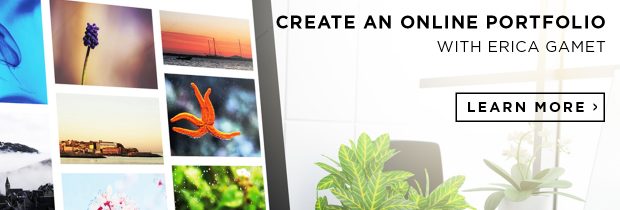As a visual artist or graphic designer, your graphic design portfolio opens doors. A sub-par presentation of your work closes them (even if you have stunning graphic design work to show off) — and may lock them for good. But as a graphic designer how do you know what a “good” portfolio even is?
Ram Castillo literally wrote the book on getting a job as a designer, and in his CreativeLive class, Create a Knockout Design Portfolio he talks about how essential online portfolios are, and, perhaps most importantly, details exactly what you need to do to assemble a good one. Ram has seen hundreds of designer portfolios that range in work from logo design to interactive design. There are common mistakes he’s witnessed across most of them.
Ram explains that your online portfolio should be, “a refined and considered selection of your best work, customized to speak to the area of design you are applying for.” In essence, your portfolio site is “proof that you exist as a designer.”
To help you prove that you exist – and do it well – Ram assembled a compilation of common graphic design portfolio mistakes that lots of rookie designers make — and how you can avoid them. You can use this top-five list to audit your existing online portfolio or to guide you as you develop a new portfolio of your best design work.
5 Graphic Design Portfolio Mistakes to Avoid:
1. Too much work.
“It’s far stronger to have five quality projects showing five design pieces within it, than 20 average projects with 10+ design pieces within them,” says Ram. For best results, definitely do not include more than 15 projects or case studies.
2. Not enough work.
“If your portfolio looks and feels bare, that’s because it is,” he explains. ” Trust your instincts. The ‘wow’ factor in your online portfolio is created through layers in your work that tell a story. Avoid putting one poster here and two logos there. Show your work as projects.”
An online portfolio is essential for attracting potential clients and launching a design career. Learn how it is done – the easy way. Learn More.
3. Contact details are hard to find.
What’s the best way to contact you — and can your potential new art director or boss find it?
“Spend 15 minutes looking through the portfolio websites of award-winning and world-renowned designers and creative directors,” Ram recommends. Not only are they full of design portfolio inspiration — they also are probably loaded with contact information.
“Take note, you’ll begin to see the patterns in the simplicity of how they present the way to reach them.”
4. It’s not mobile responsive.
The person who’s considering hiring you is probably busy, which means there’s a very good chance that they’ll be looking at your portfolio from their iPhone.
“Make sure that the real estate for ‘tapping’ and ‘clicking’ buttons, images and links are large enough to do so with ease,” says Ram. “On a mobile, it’s all about the scrolling and finger ‘tapping’ because the screen is so small. The natural behavior of the viewer embraces these movements effortlessly. It becomes too much work when the viewer requires zooming in/out and navigating the page in all directions just to see and read your content.”
5. No captions, no context.
A picture may be worth a thousand words, but a picture coupled with some words is worth even more. Especially when it highlights any and all high-profile clients you may have worked with. Don’t be shy about including clients in your portfolio design to attract new, potential clients. This will help launch your design career.
Here are the five captions Ram suggests including (in order):
Client: Name who the work was for.
Agency: Name the company or design studio you did the work at. If it’s a piece from college or university, leave it out and mention it in the ‘Client’ caption.
Challenge: What was the primary objective? (2-3 sentences at least).
Role: Specify your role and give credit where it’s due.
Results: Articulate in a simple way what this helped the client achieve.
An online portfolio is essential for attracting potential clients and launching a design career. Learn how it is done – the easy way. Learn More.














0 comments:
Post a Comment